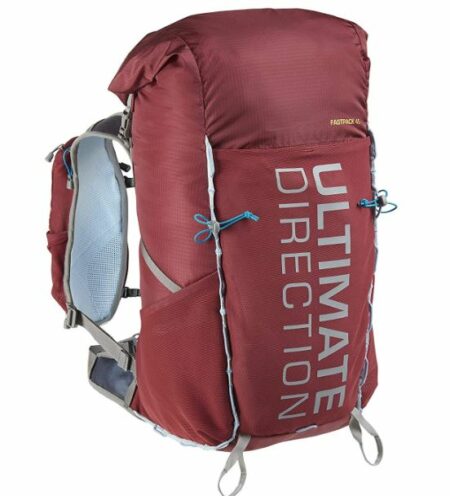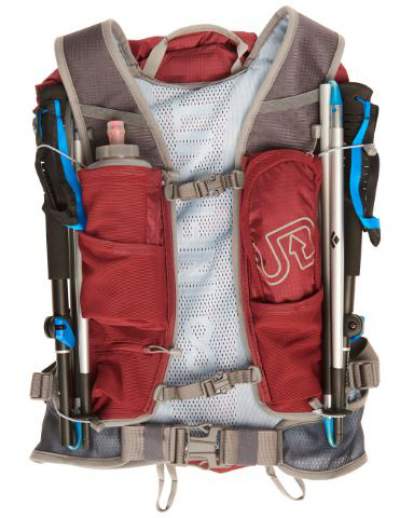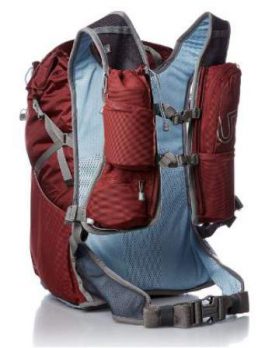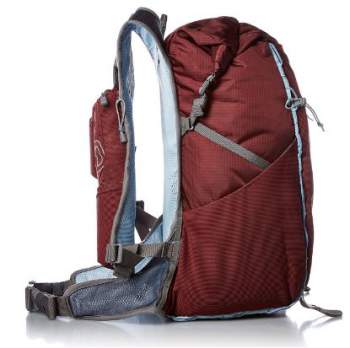This Ultimate Direction Fastpack 45 Review is about a unique pack with a hybrid design featuring train running elements in a pack large enough for overnight and weekend tours. But its true purpose remains unclear to me.

Key features & benefits
- Very lightweight.
- Roll-top closure for the main compartment.
- Unique InfiKnit back construction.
- Impressive storage space on the shoulder straps.
- Dual sternum straps.
- But, …
What is it – who is it for
The Fastpack 45 backpack is the largest in the new 2017 series which includes packs of 15, 25, 35, and 45 liters. It is built in the style of their trail running vests. In view of this, you have a lot of features on the shoulder harness, see more about this below.
This is a close-fit design, which means it is completely flexible and rides close to the body. But to put it bluntly, this means you do not have any real frame here, no padding, no ventilation, no real hip belt to support the load.
The number 45 in the name indicates its volume, but the real volume is a bit bigger, you have around 47 liters in total, see more in specifications below. So now imagine 47 liters of volume and all the weight riding mainly on the shoulders.
So this is a relatively large pack, big enough for overnight tours or light weekend tours. If you need something for day tours, you might consider the 35 liters version from this series.
Now back to its running vest-style design, I wonder who would run with such a big pack unless you have a bear chasing you? But I do love its all features on the shoulder harness; if only this all would be supported by a real frame.
So yes this is a unique design, and I see people so excited about it. But then ask yourself, why have all other brands been building packs in the past decades with all padding, frames, and massive hip belts? There is the reason for all this, and this reason is missing in this Ultimate Direction Fastpack 45. I have been using such relatively heavy padded packs with external and internal frames in the past 3 decades. If you carry a heavy load, you need a strong and supportive pack, not a vest.
A bit more – description
Now after my small rant, I still want to say more about this pack, it really looks great in many ways, and has so many unique features.
This is a top-loader of a specific kind, with a roll-top entrance to the main compartment, see it below. So you do not have the classic lid with pockets, yet this is an effective system that allows for expansion and extra load (if you can carry it without a real frame, yeah me again with objections, I am acting as a split-personality).

The pack is hydration compatible and you have a sleeve in the main compartment. The water hose port is in the middle, behind the neck.
The front of the pack is with a large stretch mesh pocket, and with yet another zippered pocket on the top, practically inside this mesh pocket.
You have dual daisy chain, low-profile but effective, dual attachment loops on the bottom, paired with dual bungee tie-offs. This is for ice axe attachment or for trekking poles. This all is visible in the picture on the top.
On each side you have one very large stretch mesh pocket, and one compression strap, they are shown below. Both are useful, you can store things here and fix them with the strap, or you can use the strap only to stabilize the load. This is all you have here.
The suspension system
Frankly, you do not have much suspension here. The back side is what they call the InfiKnit system, a continuous seamless fabric that is in the same style on the underside of shoulder straps and on the tiny hip belt. It is visible in the picture below.
So yes, this pack has a fixed hip belt, quite wide but without any padding, and this is different from the 35 liters version where the hip belt is just a removable strap. Note, the smaller 15 and 25-liter packs do not have any hip belt.
The back “panel” is just with a bit of foam, no frame, and no rigid shape. They claim this is to have it stable and close to the body when you run (with 47 liters of volume!). The shoulder straps are wide but again without any padding. So you do not have any ventilation here and the load is mainly carried on shoulders.
You have two chest straps, so this is a nice design; they are very adjustable on their rails, see them below:

The best part
But the best part of this pack is what you see in the picture below. So let me say what you have here. There are no less than 6 pockets on the shoulder harness. Two of them are zippered, three are without zippers but one of those has a cinch cord, and one is a pass-through pocket on the left shoulder strap.
In addition to this, you have two bungee cords on each shoulder strap, and you see them in the picture used for attaching the trekking poles. So, if we put aside my rants above, these are impressive features.

Two sizes
In the specifications, you will see about the two sizes, but this is only about the chest circumference, nothing to do with the torso size or pack size. So there are two ranges S/M and M/L, you will see the numbers below.
Volume
The volume is bigger than what the name says, I already mentioned this. So the total volume is 46.8 liters (2856 in³), and this includes what they call secured and unsecured volume (in pockets without zippers); so here again this is about running and possibility to lose items in the process if they are not secured…
Here is a short video about this 45 liters pack:
Here is yet another video about the whole new Fastpack series (though, they missed to mention the 15 liters pack):
Specifications
- Gender: unisex.
- Type: weekend or overnight pack.
- Best use: hard to say.
- Weight: 26.43 oz (755 g).
- Dimensions: 28.3 x 11 x 11 (72 x 28 x 28 cm).
- Volume:
– Secured volume: 39 L (2380 in³).
– Unsecured volume: 7.8 L (476 in³).
– Total volume: 46.8 L (2856 in³). - Two chest sizes:
– S/M: 26 – 44 in (66 – 112 cm).
– M/L: 30 – 50 in (76 – 127 cm). - No torso length adjustment.
- Roll-top entrance.
- Dual front daisy chains.
- Two large side mesh pockets.
- Dual sliding rail sternum straps.
- Dual front trekking pole loops & bungee tie-offs.
- Dual harness bungee attachment cords.
- Large front mesh stretch front pocket.
- Zippered front pocket.
- Fixed waist belt.
- Patented lnfiKnit mesh seamless back panel and shoulder straps system.
- Materials:
– MonoRip Mesh, breathable, non-stretch, and hydrophobic.
– 100D Robic Triple-Ripstop.
– Power Span Stretch Mesh.
Summary & rating
To conclude this Ultimate Direction Fastpack 45 Review, I love the style, design, and many of the features of this pack. But many essential features are missing. So my main issue is that I cannot see its true purpose. If you can, and if you can afford it, then you will have a nice pack, I really mean this.
Please see below how I rate this pack and my pros and cons. My rating is from a hiking pack perspective. Would you really run with such a big pack? Please let me know.
Ultimate Direction Fastpack 45
Observe also the smaller versions in this series, they are more appropriate for trail running, and almost all the features are the same except for the hip belt.
Thank you for reading. If this pack is not for you, please have a look in my page with many packs from the range 35 – 55 liters, you might find something for you. In the case of comments please use the comment box below. Have a nice day.



Carmen says
Hola que mochila me recomiendas que pese poco, q sea de 45l, para largo recorrido, tengo problemas en la espalda y no puedo llevar mucho peso. Gracias y un saludo
Jovo says
Hi, in view what you describe, you need something very different. Please check this Gregory Facet 45 Pack for Women and also the Osprey Eja Pro packs. They are ultralight and fully-featured.
James Bailand says
Dude,
An actual review, with an opinion!
THANK YOU.
I liked your review, rant included even though I have the view that you dont understand.
I prefer all the weight though my shoulders, once the weight goes though my hibs I get mobility issues and problems.
The other issue about it being frameless and back padding, and how much weight is sitting on the hips, (if any) is where I’d like more detail.
To compare it to the old UD FAST PACK 30, which I have an use.
Its basically the same bag as far as I can visually tell and from your description other than the waist straps and the back structure.
It has a (removable) plastic back structure with honeycomb, foam padding.
Tbh, the glue to hold the two parts together is not as durable as I’d like it to be, but it is a very effective and lightweight solution for back structure.
Does the 45 have something similar or has UD, gone in a different direction?
Did you carry the back with serious weight?
How tall are you and did the weight transfer though your shoulders or though shoulders and hips?
Regards,
James
Jovo says
Hi James, if you go through this site you will realize that I rarely write negative reviews. The reason is simply that I write mainly about products that I like and that I use myself, and such stuff I can recommend.
I should not have written this text as I would never use such a pack on a tour, but the motivation was its volume which makes no sense for such a type. I am also a theoretical physicist and can easily calculate the force created by the pack bouncing up and down as you run with it. It is bulky and creates a big momentum of force that destabilizes your movement.
I understand that there are such packs that people use for trail running. I just came back from the Alps and I have seen quite a few of them running up and down with small packs of just a few liters volume. See my recent texts about Cima Piazzi and Monte Vioz. But those are small packs used for day tours, nobody would run with a pack of 45 liters.
I have been carrying packs for longer than 3 decades, my first big mountain climb was in 1986. So I am a mountaineer and for such a purpose it is essential that weight is on hips so that you can breathe. There is no way you can climb a 3500 meters high mountain with a pack that rests on your shoulders alone. Ideally, you want almost all the weight on the hip belt. UD Fastpack 30 is smaller so there is no doubt it is more convenient with such a design but even this is too big.
But again, see my Stratos 24 which I used in the mentioned recent tours, there is a picture in the Monte Vioz text, this is a small pack for day tours, but I made sure that it rests on hips.
To answer your question, I am quite short, but this is not relevant for the issue. My views are based on my activity, and this is mountaineering, not a trail running.